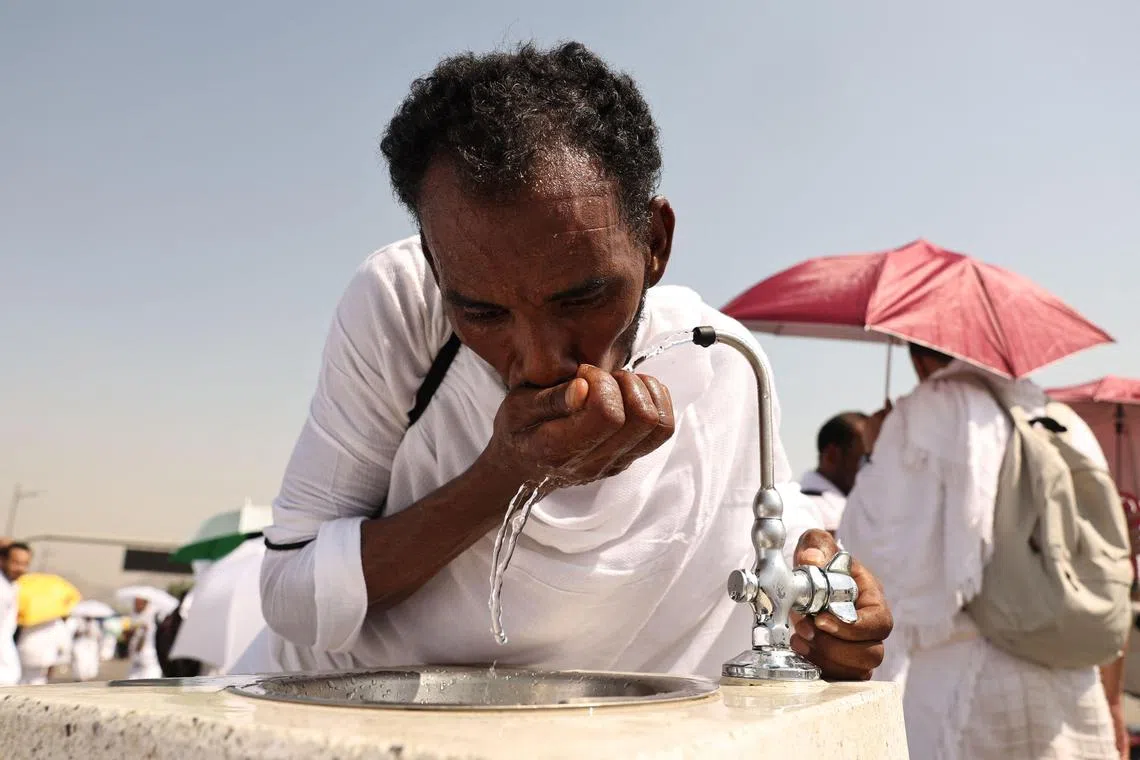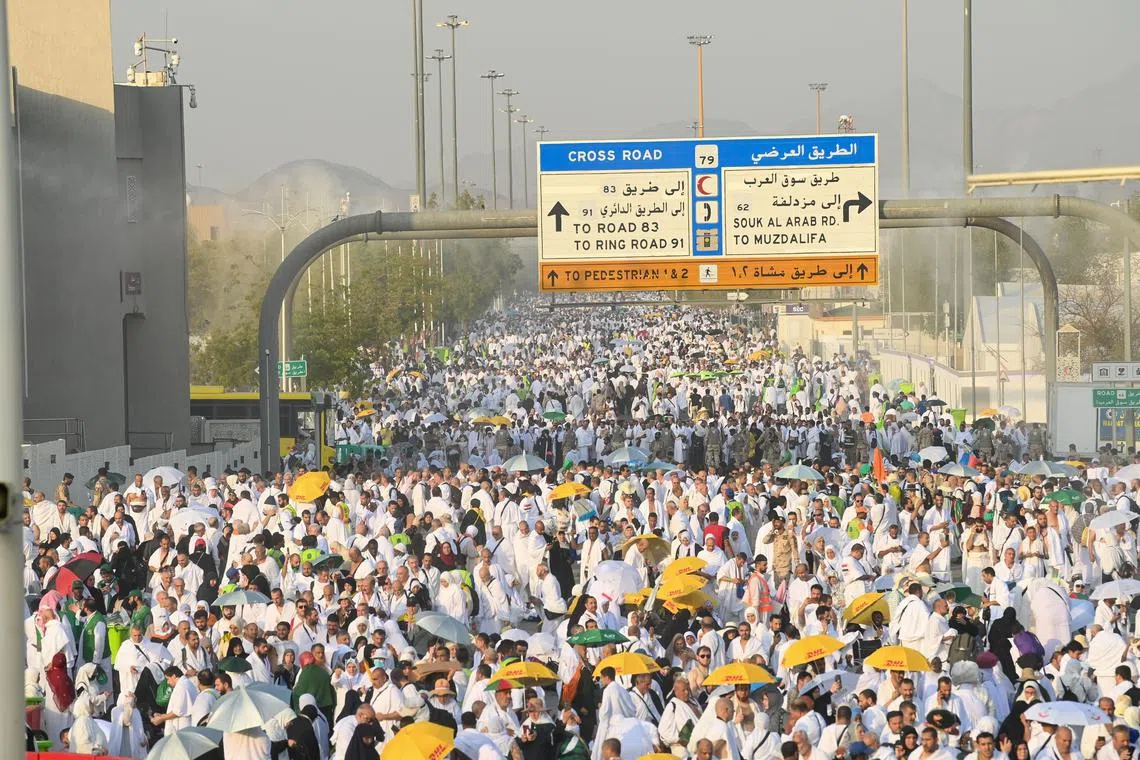Muslim pilgrims pray atop scorching Mount Arafat in haj climax
Sign up now: Get ST's newsletters delivered to your inbox

A pilgrim drinking from a water fountain at the base of Saudi Arabia's Mount Arafat, on June 15.
PHOTO: AFP
Follow topic:
MOUNT ARAFAT, Saudi Arabia – Vast crowds of Muslims gathered for hours under the hot sun atop Mount Arafat on June 15 for the high point of the annual haj pilgrimage, offering prayers, including for Palestinians in war-ravaged Gaza.
Clad in white, worshippers began arriving at dawn for the most gruelling day of the annual rites, climbing the rocky, 70m-high hill where Prophet Muhammad is believed to have given his last sermon.
The temperature on Mount Arafat hit 46 deg C, the spokesman for the national meteorology centre said on X. It created taxing conditions for pilgrims who had spent the night in a giant tented city in Mina, a valley outside Mecca, Islam’s holiest city.
“This is the most important day,” said 46-year-old Egyptian Mohammed Asser, who came prepared with a list of prayers. “I pray also for the Palestinians. May God help them.”
Some 1.8 million pilgrims have participated in the 2024 haj, the state-affiliated Al Ekhbariya channel reported on June 15, roughly the same as the total in 2023.
In 2024, the pilgrimage has unfolded in the shadow of the war in Gaza attack on southern Israel on Oct 7.
The assault resulted in the deaths of 1,194 people, mostly civilians, according to an AFP tally based on Israeli official figures.
Israel’s retaliatory military offensive has killed at least 37,266 people in Gaza, also mostly civilians, according to the Hamas-ruled territory’s Health Ministry.
Saudi Arabia’s Minister-in-charge of Pilgrimages Tawfiq al-Rabiah warned last week that “no political activity” would be tolerated during the haj.
But that did not stop at least one pilgrim from chanting in support of the Palestinians who have endured more than eight months of incessant bombardment.
“Pray for our brothers in Palestine, in Gaza... May God give victory to the Muslims,” he shouted.
In a message to haj pilgrims on June 15, Iranian Supreme Leader Ayatollah Ali Khamenei said “the ironclad resistance of Palestine and the patient, oppressed people of Gaza... must be fully supported in every way”.
Some 2,000 Palestinians are performing the haj at the special invitation of Saudi King Salman, official media outlets said.

Medics tending to a man as pilgrims make their way towards Saudi Arabia’s Mount Arafat, on June 15.
PHOTO: AFP
‘Scary’ heat
The haj, one of the world’s biggest religious gatherings, is increasingly affected by climate change, according to a Saudi study published in May that said regional temperatures were rising 0.4 deg C each decade.
The Saudi authorities have urged pilgrims to drink plenty of water and protect themselves from the sun during the rituals, which take at least five days to complete and are mostly outdoors. Since men are prohibited from wearing hats, many carry umbrellas.
Mustafa, an Algerian pilgrim who gave only his first name, clung to his umbrella which was handed out by haj organisers, saying, “it’s what saves you here”.
Another man, an Egyptian who preferred to remain anonymous, said he was drinking “a lot of juice and water” and had twice stopped to rest on the roadside.
More than 10,000 heat-related illnesses were recorded in 2023, 10 per cent of them heatstroke, a Saudi official told AFP this week.
Mr Ahmad Karim Abdelsalam, a 33-year-old pilgrim from India, admitted that he found the prospect of praying atop Mount Arafat “a little scary”.
But with the help of an umbrella and water sprays, “God willing, everything will go well”, he said.

Muslim pilgrims gathering at Saudi Arabia’s Mount Arafat, also known as Jabal al-Rahma or Mount of Mercy, during the climax of the haj pilgrimage, on June 15.
PHOTO: AFP
‘Once in a lifetime’
The haj is one of the five pillars of Islam and all Muslims with the means must perform it at least once.
Yet visas, doled out to individual countries on a quota system, can be difficult to obtain.
“It’s a chance that only comes once in a lifetime, I couldn’t not come,” said Mr Abdulrahman Siyam, a 55-year-old Iraqi pilgrim who was performing the rituals on a prosthetic leg.
After Mount Arafat, the pilgrims will head to Muzdalifah, where they will collect pebbles to carry out the symbolic “stoning of the devil” ritual in Mina on June 16.

Muslim pilgrims arriving on Mount Arafat on June 15, during the haj 2024 pilgrimage.
PHOTO: EPA-EFE
The haj is said to follow the path of Prophet Muhammad’s final pilgrimage, about 1,400 years ago.
It is an important source of legitimacy for the Al Saud dynasty, whose monarch has the title “Custodian of the Two Holy Mosques”, in Mecca and Medina.
It is also a major financial windfall for the conservative country, which is trying to develop religious tourism as part of a drive to reduce its dependence on crude oil.
Along with 2023’s 1.8 million haj pilgrims, the kingdom also welcomed 13.5 million Muslims who came to perform umrah, the pilgrimage which can be done year round.
The goal is to reach 30 million pilgrims in total by 2030. AFP

Worshippers began arriving at dawn for the most gruelling day of the annual rites, climbing the rocky, 70m-high hill where Prophet Muhammad is believed to have given his last sermon.
PHOTO: REUTERS

